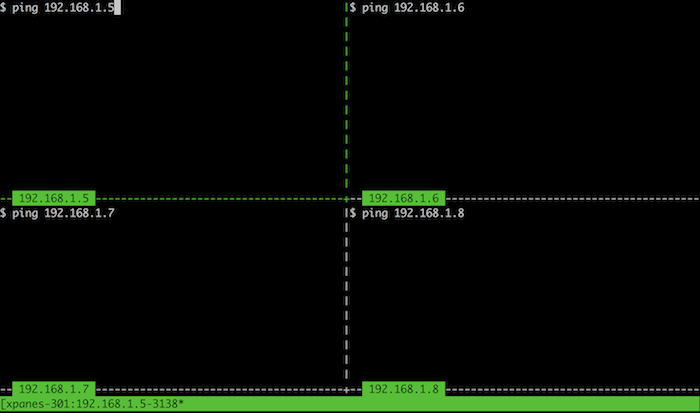Ultimate terminal divider powered by tmux
$ xpanes -c "ping {}" 192.168.0.{1..9}$ xpanes --log=~/log --ssh user1@host1 user2@host2 user2@host3$ xpanes -x -e "top" "vmstat 1" "watch -n 1 df"$ docker ps -q | xpanes -s -c "docker exec -it {} sh"- Split tmux window into multiple panes
- Build command lines from given arguments & execute them on the panes
- Runnable from outside of tmux session
- Runnable from inside of tmux session
- Record operation log
- Layout arrangement for panes
- Display pane title on each pane
- Generate command lines from standard input (Pipe mode)
- Bash (version 3.2 and more)
- tmux (version 1.8 and more)
If you prefer older tmux versions, Use stable version v2.2.3.
Please refer to wiki > Installation in further details. Here is the some examples for installing.
# Install `add-apt-repository` command, if necessary.
$ sudo apt install software-properties-common
$ sudo add-apt-repository ppa:greymd/tmux-xpanes
$ sudo apt update
$ sudo apt install tmux-xpanes$ yum install https://github.com/greymd/tmux-xpanes/releases/download/v3.1.0/tmux-xpanes_v3.1.0.rpmWith Homebrew (for macOS users)
$ brew install tmux-xpanesAttention: With this way, please install tmux manually.
Add this line to ~/.zshrc in case of zplug.
Zsh-completion for xpanes command is also available. See Wiki > Installation.
zplug "greymd/tmux-xpanes"Attention: With this way, please install tmux manually.
# Download with wget
$ wget https://raw.githubusercontent.com/greymd/tmux-xpanes/master/bin/xpanes -O ./xpanes
# Put it under PATH and make it executable.
$ sudo install -m 0755 xpanes /usr/local/bin/xpanesTwo commands xpanes and tmux-xpanes will be installed. They are actually same commands (tmux-xpanes is alias of xpanes). Use whichever you like.
Usage:
xpanes [OPTIONS] [argument ...]
Usage(pipe mode):
command ... | xpanes [OPTIONS] [<utility> ...]
OPTIONS:
-h,--help Show this screen.
-V,--version Show version.
-c <utility> Specify <utility> which is executed as a command in each panes. If <utility> is omitted, echo(1) is used.
-d,--desync Make synchronize-panes option off on new window.
-e Execute given arguments as is.
-I <repstr> Replacing one or more occurrences of <repstr> in <utility> given by -c option. Default value of <repstr> is {}.
-l <layout> Specify a layout for a window. Recognized layout arguments are:
t tiled (default)
eh even-horizontal
ev even-vertical
mh main-horizontal
mv main-vertical
-n <number> Set the maximum number of arguments taken for each pane of <utility>.
-s Speedy mode: Run command without creating a login shell.
-ss Speedy mode AND close the pane automatically at the same time as the process ends.
-S <socket-path> Specify a full alternative path to the server socket.
-t Display each argument on the each pane's border as their title.
-x Create extra panes in the current active window.
--log[=<directory>] Enable logging and store log files to ~/.cache/xpanes/logs or given <directory>.
--log-format=<FORMAT> File name of log files follows given <FORMAT>.
--ssh Same as `-t -s -c 'ssh -o StrictHostKeyChecking=no {}'`.
--stay Do not switch to new window.
--debug Print debug message.
Try this command line.
$ xpanes 1 2 3 4You will get the screen like this.
+-------------------------------+-------------------------------+
│$ echo 1 │$ echo 2 │
│1 │2 │
│ │ │
│ │ │
│ │ │
│ │ │
│ │ │
│ │ │
+-------------------------------+-------------------------------+
│$ echo 3 │$ echo 4 │
│3 │4 │
│ │ │
│ │ │
│ │ │
│ │ │
│ │ │
│ │ │
+-------------------------------+-------------------------------+
Oh, you are not familiar with key bindings of tmux?
Don't worry. Just type exit and "Enter" key to close the panes.
+-------------------------------+-------------------------------+
│$ exit │$ exit │
│ │ │
│ │ │
│ │ │
│ │ │
│ │ │
│ │ │
│ │ │
+-------------------------------+-------------------------------+
│$ exit │$ exit │
│ │ │
│ │ │
│ │ │
│ │ │
│ │ │
│ │ │
│ │ │
+-------------------------------+-------------------------------+
As shown above, input from keyboard is synchronized within multiple panes by default.
To disable the synchronization of keyboard input within panes, use -d (or --desync) option. The input is applied to only one of them. Set tmux synchronized-pane on in order to re-enable synchronization.
$ xpanes -d 1 2 3 4
-c option allows to execute original command line.
For example, try this one.
$ xpanes -c 'seq {}' 1 2 3 4You will get the screen like this.
+-------------------------------+-------------------------------+
│$ seq 1 │$ seq 2 │
│1 │1 │
│ │2 │
│ │ │
│ │ │
│ │ │
│ │ │
│ │ │
+-------------------------------+-------------------------------+
│$ seq 3 │$ seq 4 │
│1 │1 │
│2 │2 │
│3 │3 │
│ │4 │
│ │ │
│ │ │
│ │ │
+-------------------------------+-------------------------------+
seq command which generates sequential numbers is specified by -c.
As you can see, {} is replaced each arguments. This placeholder can be changed by -I option like this.
$ xpanes -I@ -c 'seq @' 1 2 3 4echo {} is used as the default placeholder when no command is specified by -c option.
Brace expansion given by Bash or Zsh is very useful to generate sequential numbers or alphabetical characters.
# Same as $ xpanes 1 2 3 4
$ xpanes {1..4}It is good to know about the conditional behavior of xpanes command, before checking further usages.
When the tmux is not open and xpanes command is executed on the normal terminal, the command's behavior is as follows:
- The command newly creates a tmux session and new window on the session.
- In addition, it separates the window into multiple panes.
- Finally, the session will be attached.
When the tmux is already open and xpanes command is executed from within the existing tmux session, the command's behavior is as follows:
- The command newly creates a window on the existing active session.
- In addition, it separates the window into multiple panes.
- Finally, the window will be active window.
When the tmux is open and xpanes command is executed from within tmux (Normal mode2)
and the command is accepting standard input ( the command followed by any other commands and pipe |), the command's behavior will be the special "Pipe mode".
It is documented in the Pipe mode section.
$ xpanes -c "tail -f {}" /var/log/apache/{error,access}.log /var/log/application/{error,access}.logThe result is like this.
+------------------------------------------+------------------------------------------+
│$ tail -f /var/log/apache/error.log │$ tail -f /var/log/apache/access.log │
│ │ │
│ │ │
│ │ │
│ │ │
│ │ │
│ │ │
│ │ │
│ │ │
│ │ │
+------------------------------------------+------------------------------------------+
│$ tail -f /var/log/application/error.log │$ tail -f /var/log/application/access.log │
│ │ │
│ │ │
│ │ │
│ │ │
│ │ │
│ │ │
│ │ │
│ │ │
│ │ │
+------------------------------------------+------------------------------------------+
Hmm? Do you want to monitor those files through the SSH? Just do it like this.
# 'ssh user@host' is added.
$ xpanes -c "ssh user@host tail -f {}" \
/var/log/apache/{error,access}.log \
/var/log/application/{error,access}.log$ xpanes -c "ssh myuser@{}" host1 host2 +-------------------------------+-------------------------------+
│$ ssh myuser@host1 │ $ ssh myuser@host2 │
│ │ │
│ │ │
│ │ │
│ │ │
│ │ │
│ │ │
│ │ │
│ │ │
│ │ │
│ │ │
│ │ │
│ │ │
+-------------------------------+-------------------------------+
--ssh option is helpful to ignore the alert message from OpenSSH. It is not required to answer yes/no question against it. Use it if you are fully sure that destination host is reliable one.
$ xpanes --ssh myuser1@host1 myuser2@host2This is same as below.
$ xpanes -t -s -c "ssh -o StrictHostKeyChecking=no {}" myuser1@host1 myuser2@host2
-t and -s options are introduced later.
$ xpanes --log=~/operation_log -c "ssh {}" user1@host1 user2@host2The result is like this.
+-------------------------------+-------------------------------+
│$ ssh user1@host1 │ $ ssh user2@host2 │
│ │ │
│ │ │
│ │ │
│ │ │
│ │ │
│ │ │
│ │ │
│ │ │
│ │ │
│ │ │
│ │ │
│ │ │
+-------------------------------+-------------------------------+
In addition, log files will be created.
$ ls ~/operation_log/
user1@host1-1.log.2017-03-15_21-30-07
user2@host2-1.log.2017-03-15_21-30-07
File name format for log file can be specified with --log-format option. Please refer to xpanes --help.
Attention: Logging feature does not work properly with specific tmux version. Please refer to wiki > Known Bugs in further details.
$ xpanes -c "ssh -t {} 'sudo some command'" host-{1,2} some-third-host.example.com
+------------------------------------+-------------------------------------+
│$ ssh -t host-1 'sudo some command' │$ ssh -t host-2 'sudo some command' │
│ │ │
│ │ │
│ │ │
│ │ │
│ │ │
│ │ │
│ │ │
│ │ │
│ │ │
│ │ │
│------------------------------------+-------------------------------------│
│$ ssh -t some-third-host.example.com 'sudo some command' │
│ │
│ │
│ │
│ │
│ │
│ │
│ │
│ │
+------------------------------------+-------------------------------------+
-s option is useful if you have following issues.
- It takes long time to open the multiple new panes because login shell loads a bunch of configures (i.e
~/.zshrcloads something ). - If you do not want to leave commands on your shell history.
With -s option, xpanes does not create a new login shell.
Instead, a command is going to be executed as a direct child process of xpanes.
Here is the example.
$ xpanes -s -c "seq {}" 2 3 4 5As you can see, each pane starts from command's result not $ seq ....
+------------------------------------------+------------------------------------------+
│1 │1 │
│2 │2 │
│Pane is dead: Press [Enter] to exit... │3 │
│ │Pane is dead: Press [Enter] to exit... │
│ │ │
│ │ │
│ │ │
│ │ │
│ │ │
│ │ │
+------------------------------------------+------------------------------------------+
│1 │1 │
│2 │2 │
│3 │3 │
│4 │4 │
│Pane is dead: Press [Enter] to exit... │5 │
│ │Pane is dead: Press [Enter] to exit... │
│ │ │
│ │ │
│ │ │
│ │ │
+------------------------------------------+------------------------------------------+
Confirmation message like Pane is dead... is shown when process ends.
To suppress the message, use -ss instead of -s.
$ xpanes -t -c "ping {}" 192.168.1.{5..8}The result is like this.
As you notice that, -t displays each argument on the each pane border.
It is called "pane title". The pane title is displayed with green background and black characters by default.
See Environment variables section to change the default format.
-x option creates extra panes to the window.
New window is not created then.
Here is the example xpanes is executed on the one of the three panes.
+-------------------------------+-------------------------------+
│$ │$ │
│ │ │
│ │ │
│ │ │
│ │ │
│ │ │
│ │ │
│ │ │
+-------------------------------+-------------------------------+
│ $ xpanes -x 4 5 6 │
│ │
│ │
│ │
│ │
│ │
│ │
│ │
+-------------------------------+-------------------------------+
Additional three panes are created.
+-------------------------------+-------------------------------+
│$ │$ │
│ │ │
│ │ │
│ │ │
│ │ │
+-------------------------------+-------------------------------+
│$ xpanes -x 4 5 6 │$ echo 4 │
│$ │4 │
│ │$ │
│ │ │
│ │ │
+-------------------------------+-------------------------------+
│$ echo 5 │$ echo 6 │
│5 │6 │
│$ │$ │
│ │ │
│ │ │
+-------------------------------+-------------------------------+
-e option executes given argument as it is.
$ xpanes -e "top" "vmstat 1" "watch -n 1 free"Then the result will be like this.
+-------------------------------+------------------------------+
│$ top │$ vmstat 1 │
│ │ │
│ │ │
│ │ │
│ │ │
│ │ │
│ │ │
+-------------------------------+------------------------------+
│$ watch -n 1 free │
│ │
│ │
│ │
│ │
│ │
│ │
+--------------------------------------------------------------+
You will get the same result with this command line.
$ xpanes -I@ -c "@" "top" "vmstat 1" "watch -n 1 free"To change the layout of panes, put an argument followed by -l option.
This is the example that lines up some panes vertically.
For example, to line up panes vertically, put ev (it is corresponding to even-vertical in tmux manual).
$ xpanes -l ev -c "{}" "top" "vmstat 1" "watch -n 1 df"It would be like this.
+-------------------------------------------------------------+
│$ top │
│ │
│ │
│ │
│ │
+-------------------------------------------------------------+
│$ vmstat 1 │
│ │
│ │
│ │
│ │
+-------------------------------------------------------------+
│$ watch -n 1 df │
│ │
│ │
│ │
│ │
+-------------------------------------------------------------+
With same way, eh (even-horizontal), mv(main-vertical) and mh(main-horizontal) are available. Please refer to xpanes --help also.
~/.cache/xpanes/socket file is automatically created when xpanes runs. Importing this socket file, different users can share their screens each other. Off course, you can specify the socket file name as you like with -S option.
- user1
[user1@host] $ xpanes -S /home/user1/mysocket a b c d ...- user2
[user2@host] $ tmux -S /home/user1/mysocket attach... then, user1 and user2 can share their screen each other.
Pipe mode is activated when xpanes command is accepting standard input.
With this mode, xpanes behaves like UNIX xargs.
# Pipe mode
$ seq 3 | xpanesWith this command line, the output would be like this.
+------------------------------+------------------------------+
│$ echo 1 │$ echo 2 │
│1 │2 │
│ │ │
│ │ │
│ │ │
│ │ │
│ │ │
│ │ │
+------------------------------+------------------------------+
│$ echo 3 │
│3 │
│ │
│ │
│ │
│ │
│ │
│ │
+------------------------------+------------------------------+
Pipe mode has two features.
xpanescommand's argument will be the common command line which will be used within all panes (this is corresponding to the-coption's argument in Normal mode).- Single line given by standard input is corresponding to the single pane's command line (this is corresponding to normal argument of
xpanesin Normal mode).
# The command line generates some numbers.
$ seq 4
1
2
3
4
# Add those numbers to xpanes command.
$ seq 4 | xpanes seq
The result will be like this.
+-------------------------------+------------------------------+
│$ seq 1 │$ seq 2 │
│ │ │
│ │ │
│ │ │
│ │ │
│ │ │
│ │ │
│ │ │
+-------------------------------+------------------------------+
│$ seq 3 │$ seq 4 │
│ │ │
│ │ │
│ │ │
│ │ │
│ │ │
│ │ │
│ │ │
+-------------------------------+------------------------------+
Off-course, -c and -I options are available.
$ seq 4 | xpanes -c 'seq {}'
## xpanes seq
## and
## xpanes -c 'seq {}'
## are same.However, giving both -c and any arguments causes error. Because the command cannot decide which argument should be used.
$ echo test | xpanes -c 'echo {}' echo
xpanes:Error: Both arguments and other options (like '-c', '-e') which updates <utility> are given.
Pipe mode allows you to make combinations between tmux and other general UNIX commands.
For example, let's prepare ~/.ssh/config file like this.
Host host1
User user1
HostName 192.168.0.2
IdentityFile ~/.ssh/id_rsa
Host host2
User user2
HostName 192.168.0.3
IdentityFile ~/.ssh/id_rsa
Host host3
User user3
HostName 192.168.0.4
IdentityFile ~/.ssh/id_rsa
Parse host name with general UNIX commands.
$ cat ~/.ssh/config | awk '$1=="Host"{print $2}'
host1
host2
host3Giving the results to xpanes ssh command.
$ cat ~/.ssh/config | awk '$1=="Host"{print $2}' | xpanes sshThe results would be like this.
+------------------------------+------------------------------+
│$ ssh host1 │$ ssh host2 │
│ │ │
│ │ │
│ │ │
│ │ │
│ │ │
│ │ │
│ │ │
+------------------------------+------------------------------+
│$ ssh host3 │
│ │
│ │
│ │
│ │
│ │
│ │
│ │
+------------------------------+------------------------------+
xpanes referes to following shell variables.
Add the statement to your default login shell's
configure file (i.e .bashrc, .zshrc) to change them as you like.
DEFAULT VALUE: tmux
It is preferentially used as a internal tmux command.
It is helpful if you want to use specific tmux version for xpanes, or enable specific options always.
Example:
export TMUX_XPANES_EXEC="/usr/local/bin/tmux1.8 -2"
# => xpanes command calls "/usr/local/bin/tmux1.8 -2" internally.DEFAULT VALUE: $HOME/.cache/xpanes/logs
Path to which log files generated by --log option are stored.
It is ignored if the path is explicitly given by --log=.
DEFAULT VALUE: [:ARG:].log.%Y-%m-%d_%H-%M-%S
Format of the log file name generated by --log option.
It is ignored if the format is explicitly given by --log-format=.
Example:
export TMUX_XPANES_LOG_FORMAT="[:ARG:]_mylog.log"DEFAULT VALUE: #[bg=green,fg=black] #T #[default]
It defines format of the pane's title.
It is corresponding to the pane-border-format.
See FORMATS section in man of tmux for further details.
It overwrites tmux's pane-border-format in the xpanes's session.
Further example is here.
DEFAULT VALUE: bottom
It defines location of the pane's title.
It is corresponding to the pane-border-status.
It overwrites tmux's pane-border-status in the xpanes's session.
Example:
# Change value from bottom to top
export TMUX_XPANES_PANE_BORDER_STATUS="top"... and let's play!
Please check out the CONTRIBUTING about how to proceed.
Please note the following points before running the test.
- Run it from outside of tmux session
- Set
allow-renameoption off
Follow this.
## Clone repository together with shunit2 (kward/shunit2)
$ git clone --recursive https://github.com/greymd/tmux-xpanes.git
$ cd tmux-xpanes
## Suppress window name change
$ echo 'set-window-option -g allow-rename off' >> ~/.tmux.conf
$ echo 'set-window-option -g automatic-rename off' >> ~/.tmux.conf
## Run smoke test
$ bash test/cases_smoke.sh
## => Testing will start ...The scripts is available as open source under the terms of the MIT License.




